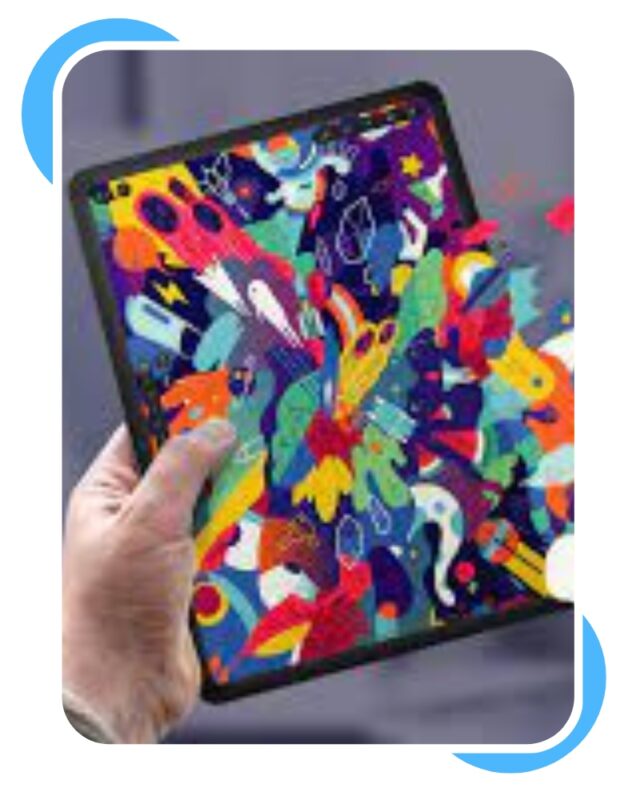
Graphic design is the art and practice of creating visual content to communicate messages and ideas to a particular audience. It uses typography, images, colours, and other elements to create visually appealing and practical designs for various media.
Graphic designers work on various projects, such as designing logos, creating marketing materials like brochures and flyers, developing packaging designs, designing websites and mobile apps, and creating animations and videos.
To be a successful graphic designer, it’s important to understand design principles, such as layout, colour theory, and typography. You should also be familiar with industry-standard software programs like Adobe Photoshop, Illustrator, and InDesign.

How To Learn Graphic Design?
There are several ways to learn graphic design, including:
Online courses
There are many online courses available that can teach you the fundamentals of graphic design and advanced techniques. Websites like Skillshare, Udemy, and Lynda offer graphic design courses ranging from beginner to advanced levels. These courses are usually self-paced so that you can learn at your speed.
University courses
Many universities and colleges offer degree programs in graphic design, which can provide a more structured and comprehensive education. These programs typically cover the theory and practice of graphic design and may include courses in typography, colour theory, and digital design tools like Adobe Creative Suite.
Bootcamps
Graphic design boot camps are intensive, short-term programs that teach you the skills you need to get a job. These programs typically last a few weeks or months and cover various topics, from design theory to software proficiency. Some popular boot camps include General Assembly, Shillington, and The Iron Yard.
Self-study
You can also learn graphic design through self-study. This involves reading books and online tutorials, practising your skills through personal projects, and seeking feedback from other designers. This method can be more flexible and affordable than other options but requires more self-discipline and motivation.
Ultimately, the best way to learn graphic design depends on your preferences, budget, and career goals. It’s essential to consider your learning style and schedule when choosing a method of education.

Benefits of Learning Graphic Design
There are many benefits to learning graphic design, including:
Career opportunities
Graphic design is a growing field with many job opportunities. Learning graphic design can lead to a career as a graphic designer, web designer, art director, or freelance designer.
Creativity
Graphic design allows you to express creativity and turn ideas into visual arrangements. You’ll learn how to use design elements like typography, colour, and imagery to communicate messages and evoke emotions.
Communication skills
Graphic design is a visual language that requires practical communication skills. Through learning graphic design, you’ll learn how to convey messages through visuals and how to communicate effectively with clients and colleagues.
Versatility
Graphic design skills are helpful in various industries, from advertising and marketing to publishing and entertainment. You can apply your skills to multiple projects, including logos, packaging design, web design, and print media.
Personal projects
Learning graphic design can also benefit your projects, such as creating invitations, designing your website, or developing a brand for your business. You can use your skills to bring your creative ideas to life and enhance your projects.
Collaboration
Graphic design often involves collaborating with others, such as clients, fellow designers, and developers. Through learning graphic design, you’ll learn how to work effectively in a team, give and receive feedback, and problem-solve creatively.
Overall, learning graphic design can open up a world of opportunities for both personal and professional growth. It can enhance your creativity, communication skills, and versatility and lead to a rewarding and fulfilling career.

Career After Learning Graphic Design
Learning graphic design can lead to a variety of career opportunities in a range of industries. Here are some common career paths for graphic designers:
Graphic Designer
This is the most common career path for graphic design graduates. Graphic designers work with clients to create visual content for print and digital media. This can include designing logos, websites, brochures, advertisements, and packaging.
Web Designer
Web designers specialize in creating websites and web applications. They work with clients to design the visual interface and layout of websites and may also be responsible for coding the website or collaborating with developers.
Art Director
Art directors are responsible for a project’s visual style and direction, such as advertising campaigns or movies. They oversee the work of graphic designers and other artists to ensure that the final product meets the client’s vision.
User Experience (UX) Designer
UX designers focus on creating user-friendly and intuitive experiences for websites, apps, and other digital products. They use design thinking and user research to create interfaces that are easy to use and navigate.
Packaging Designer
Packaging designers create the visual design for product packaging. They work with clients to create a visually appealing and functional design and may also be responsible for selecting materials and overseeing the production process.
Freelance Designer
Many graphic designers work as freelancers, either as their sole career or as a supplement to a full-time job. Freelance designers work with clients on a project-by-project basis and can choose their projects and schedule.
Overall, many career paths are available for those who learn graphic design. With a strong portfolio and the right skills, you can pursue a rewarding and fulfilling career in the design industry.

Salary After Learning Graphic Design in India
The salary for a graphic designer in India can vary depending on several factors, such as location, experience, and industry. Here are some estimates of the average salary range for graphic designers in India:
- An entry-level graphic designer in India can expect to earn an average salary of around Rs. 2.5 – 3.5 lakhs per year.
- A mid-level graphic designer with 5-8 years of experience can earn an average salary of around Rs. 5 – 7 lakhs per year.
- A senior-level graphic designer with 10+ years of experience can earn an average salary of around Rs. 10 – 15 lakhs per year.
These estimates are based on data from various sources and may vary depending on factors such as the company, location, and industry. Additionally, freelance graphic designers in India may earn different salaries based on their project rates and workload.
Learning graphic design in India can lead to a promising career with potential growth and advancement. It’s essential to continue to develop your skills and stay up-to-date with industry trends to stay competitive in the job market.

How to Succeed in a Graphic Design
Here are some tips on how to succeed in graphic design:
Develop a Strong Portfolio
Your portfolio showcases your skills and experience as a graphic designer. Ensure your portfolio is well-organized and includes a variety of your best work.
Stay Up-to-Dateu
Keep up with the latest trends, techniques, and software in the graphic design industry. Attend workshops, conferences, and online courses to stay current with your skills.
Build a Strong Network
Networking is crucial in the graphic design industry. Connect with other designers, industry professionals, and potential clients through social media, online forums, and in-person events.
Be Flexible
Be willing to adapt to different projects, clients, and styles. Flexibility and adaptability are critical traits for success in the graphic design industry.
Communicate Effectively
Communication is a crucial skill in graphic design. Be clear and concise in your communication with clients, and be open to feedback and criticism.
Be Professional
Show professionalism in all work aspects, including interactions with clients, deadlines, and invoicing.
Develop Other Skills
Graphic design is a multi-disciplinary field, and developing other skills such as copywriting, coding, and marketing can make you more valuable to clients and employers.
By following these tips and continually learning and growing in your skills and knowledge, you can succeed in the competitive world of graphic design.
Common Challenges in Learning Graphic Design
Learning graphic design can be a rewarding experience but can also come with challenges. Here are some common challenges that students may face when learning graphic design:
Software Proficiency
Graphic design software can be complex and challenging to learn, especially for beginners. Students may need help mastering the tools and features of popular software like Adobe Photoshop and Illustrator.
Creative Block
Designing can be a creative process; students may need help with creative blocks to develop new and innovative ideas.
Time Management
Design projects can be time-consuming, and students may need help managing their time effectively to meet project deadlines.
Criticism and Feedback
Design is a subjective field, and students may struggle with receiving constructive criticism and feedback on their work.
Technical Skills
Designing requires technical skills such as colour theory, typography, and layout. Students may need help mastering and applying these skills effectively in their designs.
Conceptualizing
Design projects require students to understand the needs and objectives of their clients and to conceptualize design solutions that meet those needs. This can be challenging for students who are new to the field.
Keeping Up with Industry Trends
The graphic design industry constantly evolves, and students may need help keeping up with new trends and techniques.
By recognizing and addressing these common challenges, students can work towards developing the skills and knowledge needed to become successful graphic designers. Staying patient, motivated, and dedicated to your learning process is essential.

Advantages and Disadvantages of Graphic Design
Graphic design creates visual content using typography, images, and other graphical elements to convey a message or communicate an idea. This field has both advantages and disadvantages, which are important to consider for anyone interested in pursuing a career in graphic design or working with graphic designers. In this response, I will discuss some of graphic design’s main advantages and disadvantages.
Advantages of Graphic Design
Visual Communication: Graphic design is a powerful tool for visual communication. It allows designers to communicate complex ideas and messages through optical elements such as images, typography, and colour.
Brand Identity: Graphic design plays a critical role in building brand identity. A well-designed logo, website, and marketing materials can help establish brand recognition and create a consistent visual identity for a business.
Creativity and Innovation: Graphic design allows designers to express their creativity and innovate with new design concepts and ideas.
Career Opportunities: Graphic design is a highly sought-after skill in many industries, and there are various career opportunities available for designers, including freelance work, agency work, and in-house design positions.
Problem-Solving: Graphic design requires critical thinking and problem-solving skills to create effective strategies that meet the needs of clients and audiences.
Disadvantages of the Graphic Design
Time-Consuming: Creating high-quality graphic designs can be time-consuming, especially for complex projects requiring much research and planning.
Subjective: Design is a personal field, and what may appeal to one person may not to another. This can make creating designs that appeal to a broad audience challenging.
Technical Skill: Graphic design requires a certain level of technical skill, including knowledge of design software and technical skills such as colour theory, typography, and layout. This can be challenging for some individuals who are not comfortable with the technical aspects of design.
Constant Learning: The graphic design industry constantly evolves, and designers must stay current with new technologies and trends to remain competitive.
Working Under Pressure: Graphic designers often work under tight deadlines and pressure from clients to produce high-quality designs quickly.

FAQs Related to Graphic Design
Sure, I would be happy to help! Here are some frequently asked questions related to Graphic Design:
Graphic design is the art and practice of creating visual content to communicate information or messages to a specific audience. It uses typography, images, colours, and other elements to create aesthetically pleasing designs and effectively convey messages.
Some essential skills needed for graphic design include creativity, a good eye for design, proficiency in design software such as Adobe Photoshop and Illustrator, an understanding of colour theory, typography, layout, and composition, and strong communication and problem-solving skills.
Graphic design plays a critical role in marketing by creating visually appealing designs that communicate a brand’s message and values to its target audience. It helps businesses establish their brand identity, create marketing materials such as brochures, websites, and social media content, and communicate complex information to customers.
Various career opportunities are available in graphic design, including freelance work, agency work, and in-house design positions. Some job titles in the field include graphic designer, web designer, art director, user experience designer, and creative director.
Some ways to improve your graphic design skills include taking online or university courses, attending workshops or design conferences, practising regularly, seeking feedback, and staying up-to-date with industry trends and technology.
Some of the most common graphic design software programs include Adobe Photoshop, Adobe Illustrator, InDesign, Sketch, and Canva.
